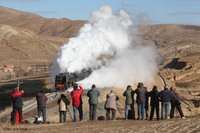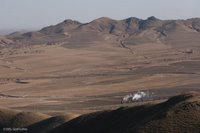 Yesterday, November 17, a German tour group chartered a special train over Jingpeng Pass. Until last spring, when dieselization was completed, Jingpeng was the crown jewel of all steam railroading left in China. The pass is in the middle of the Ji-Tong Line, about 40 miles west of Daban where the line makes its only major mountain crossing. Grades there are two times steeper than they are any place else on the railway, but are still kept to a relatively modest 1.2% thanks to good engineering and modern construction technology (the line was completed only 10 years ago).
Yesterday, November 17, a German tour group chartered a special train over Jingpeng Pass. Until last spring, when dieselization was completed, Jingpeng was the crown jewel of all steam railroading left in China. The pass is in the middle of the Ji-Tong Line, about 40 miles west of Daban where the line makes its only major mountain crossing. Grades there are two times steeper than they are any place else on the railway, but are still kept to a relatively modest 1.2% thanks to good engineering and modern construction technology (the line was completed only 10 years ago).The line twists and turns through multiple horseshoe curves as it wraps itself around the mountains, up one side and down the other with track on three different levels, swinging out over towering concrete viaducts and punching through the only six tunnels on the entire 900-km route. All of this was steam-powered until less than two years ago, pairs of 2-10-2 QJs lifting 2300 ton trains, steam billowing high in the crystal clear, biting mountain air of winter, exhaust echoing up and down the valleys for nearly an hour at a time with every uphill train.
I never got to see it, though. Not like that.
What I got to see was a small train of six coaches pulled by a pair of steam locomotives. 7038 and 7119 put on as good of a show as they could with such a light load, but they looked rather silly coupled tender-to-tender, one always running backwards on account of no turning facilities at Jingpeng Station, the western end of the run from Daban. Zhang Zhi En graciously invited Ron and me to ride in his car with him and another Chinese photographer (though at some peril to our lives at some points), so we chased the special along with a few hundred other railfans who either wanted one last chance to see steam over The Pass or those like me who just missed seeing it in its glory.
 We raced with the other taxis and buses from location to location, trying to get in as many views and photos as we could of what could be one of the last steam trains ever to make the run up the valley from Reshui, through the long tunnel near the summit, sidestepping down around Hadashan Mountain and into the station at Jingpeng. Neimenggu TV was once again on the scene, and even filmed Ron, Zhang Zhi En and me taking a photo of the train. Despite the crowds and the less-than-authentic-looking train, I did manage a few decent photos, which I suppose was the purpose of the event for everyone involved.
We raced with the other taxis and buses from location to location, trying to get in as many views and photos as we could of what could be one of the last steam trains ever to make the run up the valley from Reshui, through the long tunnel near the summit, sidestepping down around Hadashan Mountain and into the station at Jingpeng. Neimenggu TV was once again on the scene, and even filmed Ron, Zhang Zhi En and me taking a photo of the train. Despite the crowds and the less-than-authentic-looking train, I did manage a few decent photos, which I suppose was the purpose of the event for everyone involved.For Ron, it was all a bit anti-climatic. He discovered Jingpeng Pass and the Ji-Tong Line on his own in 1997, one of the first westerners to do so and long before it was publicized in the railfan press. He’s fired laboring engines up the entire grade, long before the crews ever thought to charge for that privilege. He’s hiked the hills and waited alone in the night, long after the tour groups went to bed, his flashes at the ready as the whistle from an uphill train leaving Jingpeng wafted up the valley to his lonely post at Simingyi.
I’ll never to get to climb high and alone in those craggy hills to find a wind-swept perch with a view down the valley where I could watch a little puff of white steam grow larger and larger for 45 minutes or more. I didn’t know of The Pass until a 2003 TRAINS magazine article. I could have put all my other photography projects on hold and made a week-long trip or two, but that’s not the way I work. I’m slow, and I need a much longer time, or many more visits, to wrap my arms around a place. And for me, if I can’t achieve that total immersion, I’d rather skip the token sprinklings altogether.
Still, I’m glad I got to see The Pass, if only for a day. I think I felt closest to it when I watched a pair of rumbling diesels grind upgrade with a heavy freight train. It’s not nearly as spectacular as the photos I've seen with steam, but moving that freight between western and northeastern China remains the railway’s reason for being there. It’s still a special place to watch that progression of cargo across a vast country, but it feels like something is missing -- something gone so long from the mountain crossing of the U.S. that's become difficult to remember exactly what. I’ve often criticized the American photographers of the 1950s who packed away their cameras with the end of steam. On this trip I’ve forgiven them a little, as I’ve struggled to find the urge to photograph the utilitarian diesels, knowing that the sublimity of steam was so recent in its passing here.
 Ron and I will leave the Ji-Tong Line next week to spend the remainder of our time in China visiting a few railways in the northeast, including (for me) a second visit to Huanan. We may return to Daban for a day or two at the end of this trip, as the current word is that steam operations will conclude on December 10th. It would be nice to be here for the end, if the timing works. For me, my fondest memories of Ji-Tong won’t be of The Pass, nor will I spend too long dwelling on my one teasing taste of a thing I can no longer have. Instead, I’ll remember the evenings with those friendly crossing gatekeepers out on the line from Daban to Chabuga, drinking their tea and eating their food and marveling at the generosity they give so freely on their Y600 ($75US) a month. I’ll remember those mountains of Gulumanhan, Lindong and Tianshan where I stood alone in sunlight and in moonlight, filling the hours with a thousand thoughts, ears and eyes ever-straining for the first hint of the next uphill double-header, two steam locomotives running not for show but for duty, their spectacle just another link in a cross-country chain.
Ron and I will leave the Ji-Tong Line next week to spend the remainder of our time in China visiting a few railways in the northeast, including (for me) a second visit to Huanan. We may return to Daban for a day or two at the end of this trip, as the current word is that steam operations will conclude on December 10th. It would be nice to be here for the end, if the timing works. For me, my fondest memories of Ji-Tong won’t be of The Pass, nor will I spend too long dwelling on my one teasing taste of a thing I can no longer have. Instead, I’ll remember the evenings with those friendly crossing gatekeepers out on the line from Daban to Chabuga, drinking their tea and eating their food and marveling at the generosity they give so freely on their Y600 ($75US) a month. I’ll remember those mountains of Gulumanhan, Lindong and Tianshan where I stood alone in sunlight and in moonlight, filling the hours with a thousand thoughts, ears and eyes ever-straining for the first hint of the next uphill double-header, two steam locomotives running not for show but for duty, their spectacle just another link in a cross-country chain.  And I’ll remember standing with Ron in the open doorway of the dining car with the conductor looking on, the night wind in our faces as 7081’s rods flashed in the moonlight, and me, just for a moment, so close to that boy of 12 with the big engineer’s hat, red bandana and goggles, perched in the vestibule of a West Virginia steam excursion while Grandma and Grandpa or Uncle Steve peered out the windows of their coach seats, and me content to forever watch the world go by beneath a salt and pepper plume of steam and coal smoke.
And I’ll remember standing with Ron in the open doorway of the dining car with the conductor looking on, the night wind in our faces as 7081’s rods flashed in the moonlight, and me, just for a moment, so close to that boy of 12 with the big engineer’s hat, red bandana and goggles, perched in the vestibule of a West Virginia steam excursion while Grandma and Grandpa or Uncle Steve peered out the windows of their coach seats, and me content to forever watch the world go by beneath a salt and pepper plume of steam and coal smoke.
1 comment:
Scott:
Glad that you "escaped" without further mishap. Definitely a long way to go for an hour's worth of photography! Have been enjoying your adventures, and sympathize with the lack of space in transportation vehicles, etc.
Happy Thanksgiving!
Post a Comment